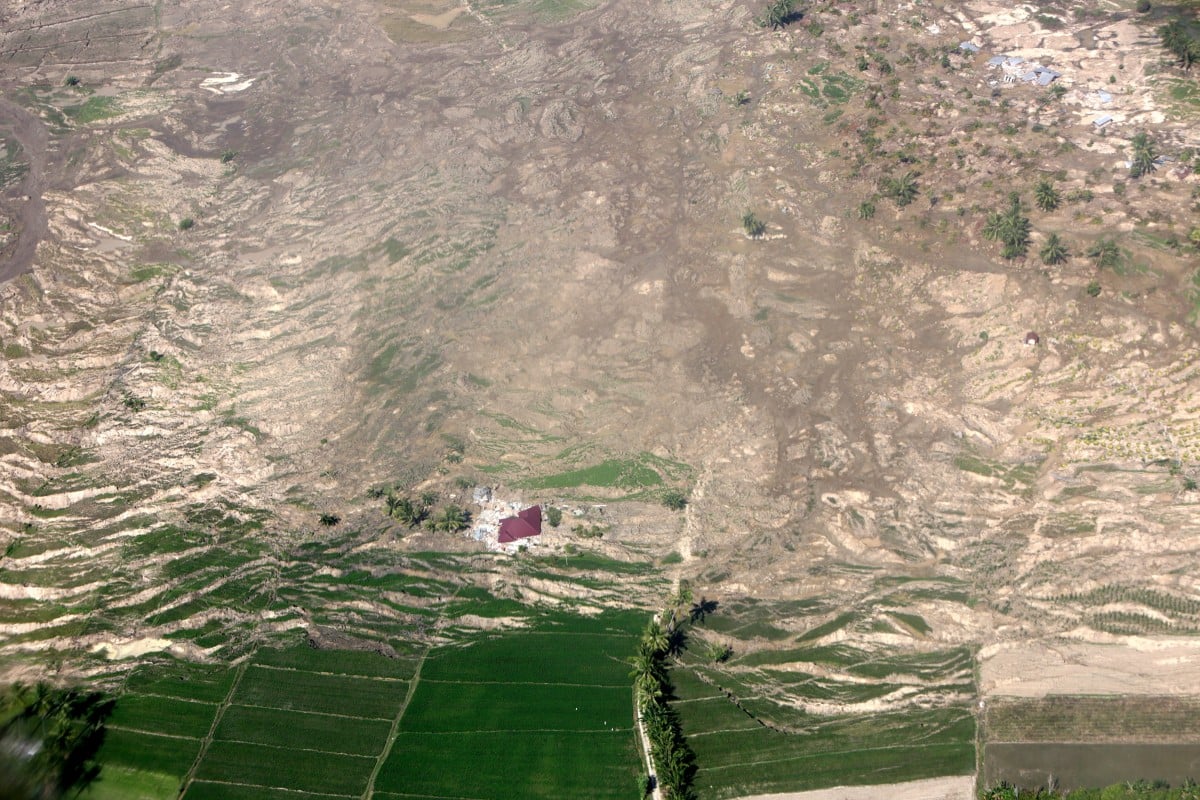
What is liquefaction and how did it make the Indonesia earthquake and tsunami worse?
During earthquakes, the ground can suddenly turn to water. Here's why this terrifying phenomena happens
 An aerial view of liquefaction, following the earthquake in Palu, Central Sulawesi. The soil makes a wave pattern as it becomes liquid.
An aerial view of liquefaction, following the earthquake in Palu, Central Sulawesi. The soil makes a wave pattern as it becomes liquid.Liquefied soil caused numerous buildings to collapse in the Indonesian city of Palu after Friday’s magnitude 7.5 earthquake, which has killed more than 1,200 people. Here’s a brief explanation of liquefaction, how common it is, and where it is likely to happen.
What is liquefaction
Liquefaction is a phenomenon where saturated sand and silt take on the characteristics of a liquid during the intense shaking of an earthquake, according to the United States Geological Survey website. It takes place when a quake has increased water pressure in saturated soil and made particles in the soil lose contact with each other, making the soil - particularly sandy soil - act like liquid. The effect has been likened to slapping a wet, hard beach and the sand beneath your palm becomes jelly.
What happened in Sulawesi
In the Palu neighborhood of Balaroa, about 1,700 houses were swallowed up when the earthquake caused soil to liquefy, the national rescue agency said. Satellite images of the Petobo district, south of Palu’s airport, showed another large area of urban development seemingly wiped clear of buildings.
“When the quake hit, the layers below the surface of the earth became muddy and loose,” said Sutopo Purwo Nugroho, spokesman of Indonesia’s national disaster mitigation agency.
“Mud with such large mass volume drowned and dragged the housing complex in Petobo so that most of them became as if they were absorbed. We estimate 744 units of houses are there.”
Amateur video footage appeared to show trees, buildings and even a large communications tower being tossed around in fast-moving landslides. We were was unable to verify the footage.
Among those killed were 34 children at a Christian bible study camp that was hit by liquefaction, a Red Cross official said.
Indonesia tsunami 2018: Death toll rises to more than 1,200 on island of Sulawesi
Where is it most likely to happen?
Liquefaction is most likely to happen in reclaimed land. Areas with shallow water tables and close to the sea or rivers are also susceptible to liquefaction.
“Compared with what’s been formed naturally over a long period of time, what’s manmade has been constructed for a short period of time, where soil particles are only loosely connected to each other,” said Toshitaka Kamai, professor at Kyoto University’s Disaster Prevention Research Institute.
The eastern Japanese city of Urayasu, where the majority of land was formed by reclamation, saw 86 per cent of its land affected by liquefaction following the massive 2011 earthquake. It took the city six years to repair all the damaged underground sewerage, water and gas facilities.
“It renders underground pipes mangled mess. One of its characteristics is it takes time to recover (from liquefaction damage),” Yoshiharu Yokoyama, an executive at Jibannet, which provides soil analysis services.
Conditions that could lead to liquefaction can be found in many places in Indonesia and throughout Asia, said Mark Quigley, Associate Professor of Earthquake Science at the University of Melbourne.
“People need to live in places that are habitable for a whole bunch of reasons. In the case of Palu it’s on a very nice, natural bay. It’s on a river that would have provided historically a source of water for them. There’s a lot of really mountainous jungle-y terrain all around it, it’s not like they had endless opportunity to just choose whatever site they wanted.”
Hurricanes Harvey and Irma were hard, but most of the world’s disasters are ignored
How common is it?
Earthquake and soil experts say liquefaction is fairly common. It happened after the massive 9.0 magnitude quake that hit eastern Japan in 2011 and numerous other Japanese earthquakes in recent years.
It has also been reported in several previous Indonesian earthquakes, major quakes in Christchurch, New Zealand in 2010 and 2011, and the Great Alaska Earthquake of 1964.
